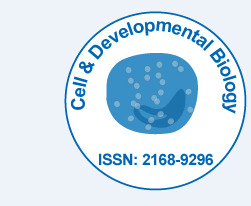
Cell & Developmental Biology
Open Access
ISSN: 2168-9296

ISSN: 2168-9296
Opinion Article - (2025)Volume 14, Issue 1
Single-cell RNA sequencing (scRNA-seq) has revolutionized our understanding of cellular heterogeneity during development by enabling the comprehensive characterization of gene expression profiles at individual cell resolution. This technology has revealed unexpected diversity within seemingly homogeneous cell populations, uncovered novel intermediate cell states, and provided detailed maps of developmental trajectories. The application of scRNA-seq to developmental biology has fundamentally changed our perspective on how cellular diversity emerges and is maintained throughout embryogenesis.
The technical foundation of scRNA-seq relies on the isolation of individual cells, reverse transcription of mRNA molecules, and amplification of cDNA libraries for high-throughput sequencing. Recent advances in droplet-based platforms, such as Drop-seq and 10x Genomics, have enabled the simultaneous analysis of thousands to millions of individual cells. These platforms create water-in-oil emulsions where individual cells are encapsulated with barcoded beads, allowing for the assignment of sequencing reads to specific cells. The resulting data matrices contain gene expression measurements for thousands of genes across thousands of cells, creating high-dimensional datasets that require sophisticated computational approaches for analysis.
Computational analysis of scRNA-seq data involves multiple steps, including quality control, normalization, dimensionality reduction, and clustering. Quality control procedures remove low-quality cells and genes, while normalization methods account for technical variation between cells. Principal Component Analysis (PCA) and Uniform Manifold Approximation And Projection (UMAP) are commonly used for dimensionality reduction, creating low-dimensional representations that preserve the major sources of variation in the data. Graph-based clustering algorithms identify groups of cells with similar expression profiles, revealing distinct cell types and states.
Trajectory inference methods have emerged as powerful tools for reconstructing developmental pathways from scRNA-seq data. These algorithms, including Monocle, PAGA, and RNA velocity, infer the temporal ordering of cells along developmental trajectories by analyzing the similarity of gene expression profiles. RNA velocity analysis examines the ratio of spliced to unspliced transcripts to predict the future transcriptional state of individual cells, providing insights into the direction and speed of developmental transitions. These approaches have revealed branching patterns in developmental lineages and identified key transcription factors that regulate lineage decisions.
The application of scRNA-seq to embryonic development has revealed remarkable cellular heterogeneity at all stages of development. During early embryogenesis, scRNA-seq has identified distinct cell states within the inner cell mass and trophectoderm, revealing the molecular basis of the first lineage decision. Analysis of gastrulation-stage embryos has mapped the emergence of the three germ layers and identified intermediate cell states that express markers of multiple lineages. These studies have revealed that lineage commitment is a gradual process involving the progressive restriction of transcriptional programs rather than abrupt switches between cell states.
Organ-specific scRNA-seq studies have provided detailed atlases of cellular diversity in developing tissues. Analysis of the developing nervous system has revealed the incredible diversity of neuronal subtypes and the complex patterns of gene expression that specify different brain regions. Studies of developing limbs have identified the cellular basis of pattern formation and the role of signaling gradients in establishing positional identity. Cardiac development studies have mapped the emergence of different cardiac cell types and identified the transcriptional programs that control heart morphogenesis.
The integration of scRNA-seq with other single-cell technologies has provided multi-modal insights into developmental processes. Single-cell ATAC-seq (scATAC-seq) measures chromatin accessibility at the single-cell level, revealing the regulatory landscapes that control gene expression during development. Combined scRNA-seq and scATAC-seq experiments have linked transcription factor expression to chromatin accessibility changes, providing mechanistic insights into transcriptional regulation. Single-cell proteomics and metabolomics approaches are beginning to provide complementary information about cellular states and functions.
Spatial transcriptomics technologies, including spatial barcoding and in situ sequencing methods, have added spatial context to single-cell gene expression data. These approaches preserve the spatial relationships between cells while providing transcriptomic information, enabling the reconstruction of tissue architecture and the identification of spatially restricted gene expression patterns. The integration of spatial and single-cell transcriptomics has revealed how cell-cell interactions and positional information influence gene expression during development.
Single-cell transcriptomics has transformed our understanding of cellular heterogeneity during development, revealing the complex patterns of gene expression that underlie developmental processes. The technology has uncovered unexpected cellular diversity, mapped developmental trajectories, and provided mechanistic insights into lineage specification and tissue morphogenesis. As single-cell technologies continue to advance, we can expect even more detailed characterizations of developmental processes and the identification of novel therapeutic targets for developmental disorders. The future of developmental biology will be increasingly driven by single-cell approaches that integrate multiple molecular modalities with spatial information.
Citation: Bhanot F (2025). Single-Cell Transcriptomics Reveals Cellular Heterogeneity in Developmental Lineages. Cell Dev Biol. 14:383.
Received: 28-Feb-2025, Manuscript No. CDB-25-38145; Editor assigned: 03-Mar-2025, Pre QC No. CDB-25-38145 (PQ); Reviewed: 17-Mar-2025, QC No. CDB-25-38145; Revised: 24-Mar-2025, Manuscript No. CDB-25-38145 (R); Published: 31-Mar-2025 , DOI: 10.35248/2168-9296.25.14.383
Copyright: © 2025 Bhanot F. This is an open-access article distributed under the terms of the Creative Commons Attribution License, which permits unrestricted use, distribution, and reproduction in any medium, provided the original author and source are credited.